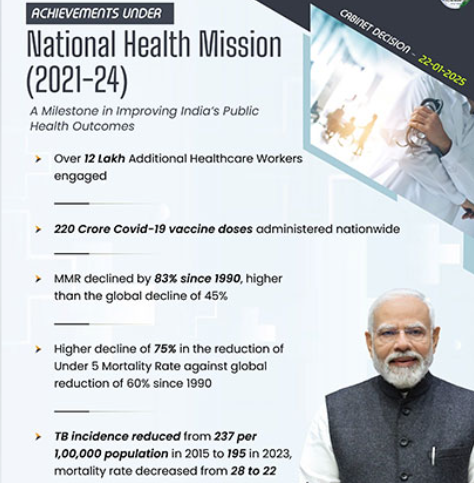National Health Mission has curbed several public health concerns, says Centre’s report
(Source – The Hindu, International Edition – Page No. – 6)
| Topic: GS2 – Social Justice – Health |
| Context |
|

Achievements in Human Resources
- NHM has expanded human resources in the healthcare sector.
- In FY 2021-22, NHM added 2.69 lakh healthcare workers, including doctors, nurses, allied health professionals, and public health managers.
- In FY 2022-23, 21 lakh workers were engaged, including 1.29 lakh community health officers (CHOs).
- In FY 2023-24, 5.23 lakh healthcare professionals were added, including 1.38 lakh CHOs.
Decline in Maternal and Infant Mortality
- The Maternal Mortality Ratio (MMR) has dropped by 83% since 1990, a much higher reduction than the global average of 45%.
- The Infant Mortality Rate (IMR) fell from 39 per 1,000 live births in 2014 to 28 in 2020.
- The Total Fertility Rate (TFR) decreased from 2.3 in 2015 to 2.0 in 2020.
India’s Progress Toward SDG Targets
- These improvements are indicators that India is on track to meet its United Nations Sustainable Development Goals (SDG) targets for maternal, child, and infant mortality ahead of the 2030 deadline.
- NHM has also contributed to the elimination and control of various diseases, including reducing the incidence of tuberculosis (TB).
| National Health Mission (NHM) |
○ Reproductive, Maternal, Newborn, Child Health + Adolescent Health: Focus on reducing maternal and child mortality. ○ Health System Strengthening: Improving health infrastructure and human resources. ○ National Disease Control Programs: Addressing diseases like TB, malaria, and leprosy. ○ AYUSH: Promoting traditional medicine for holistic health.
|
| Practice Question: Discuss the objectives, components, and challenges of the National Health Mission (NHM) in India. How does NHM contribute to achieving Universal Health Coverage? (150 Words /10 marks) |
Check more... Is the government encouraging ‘crosspathy’?

